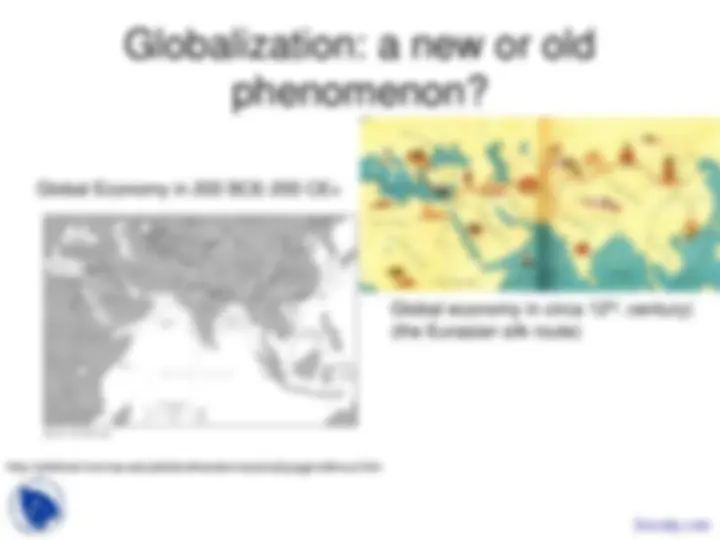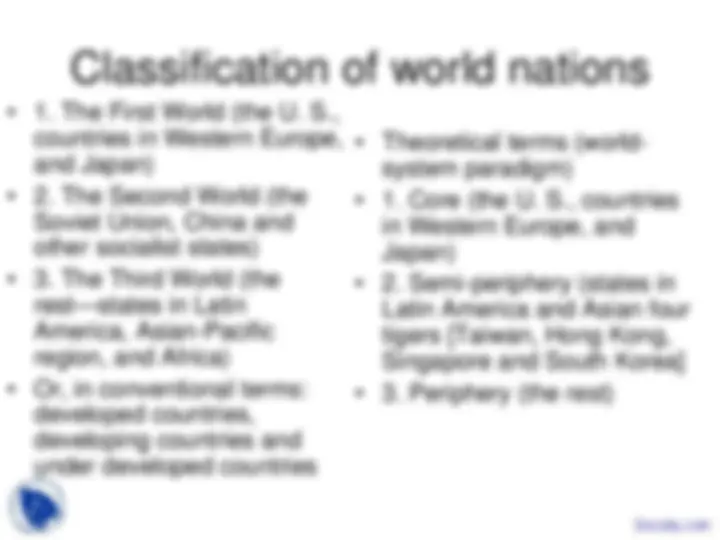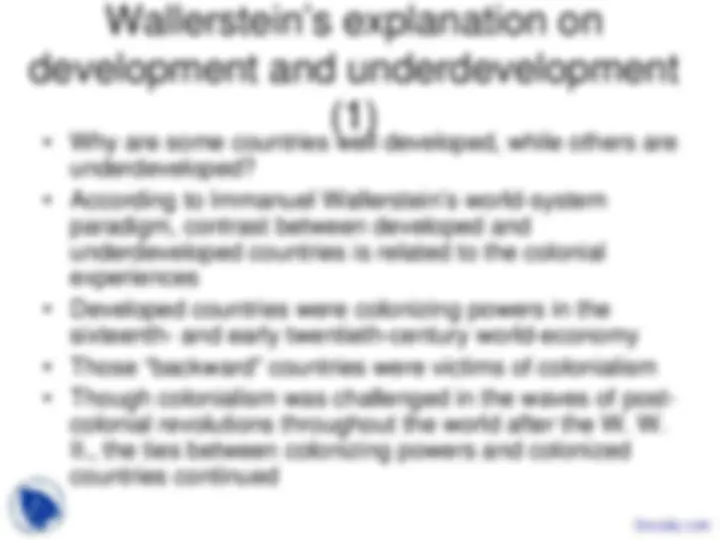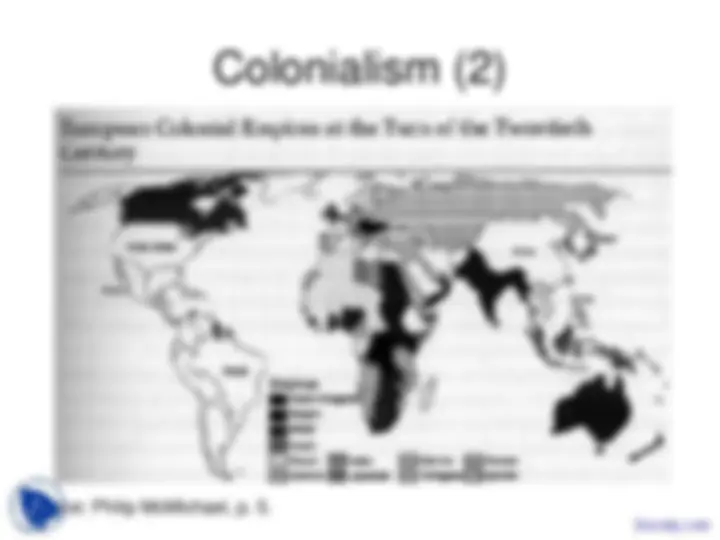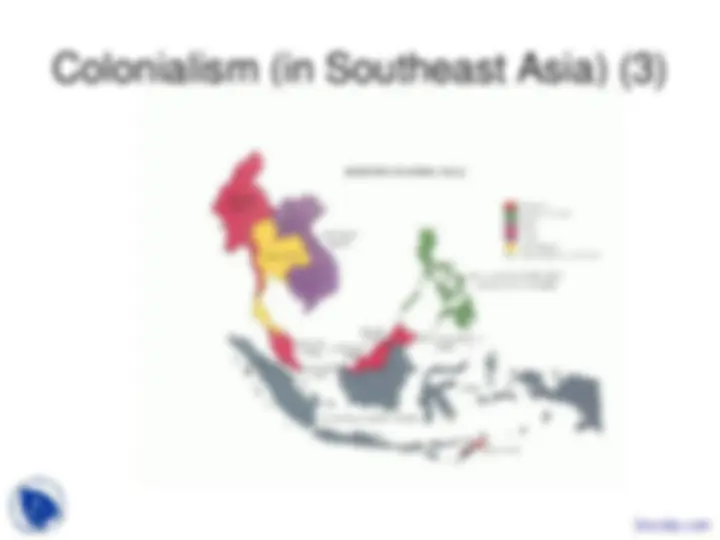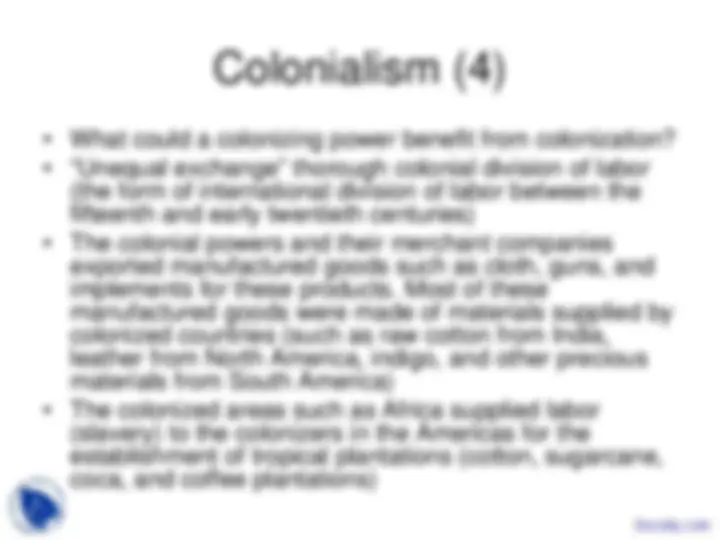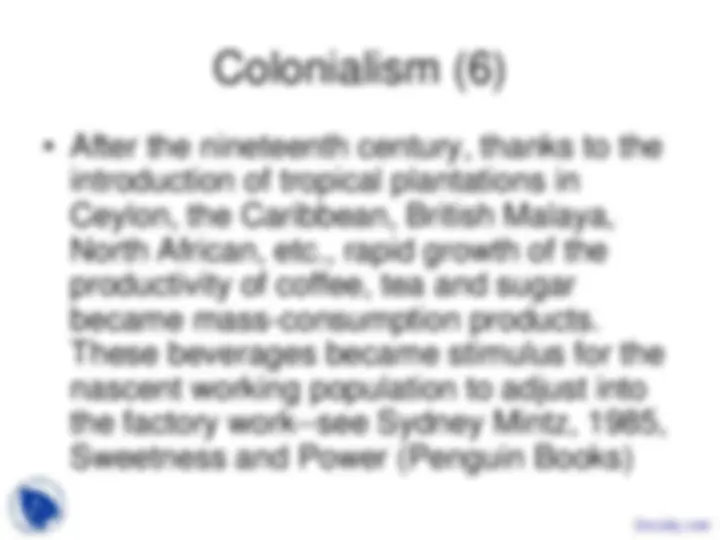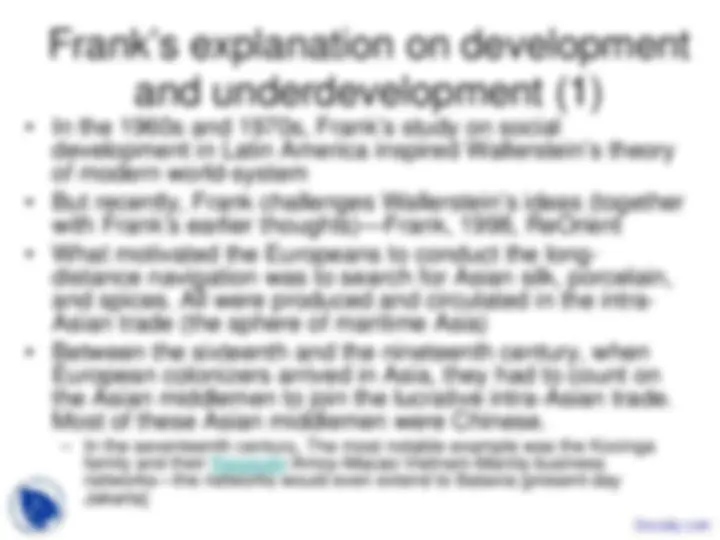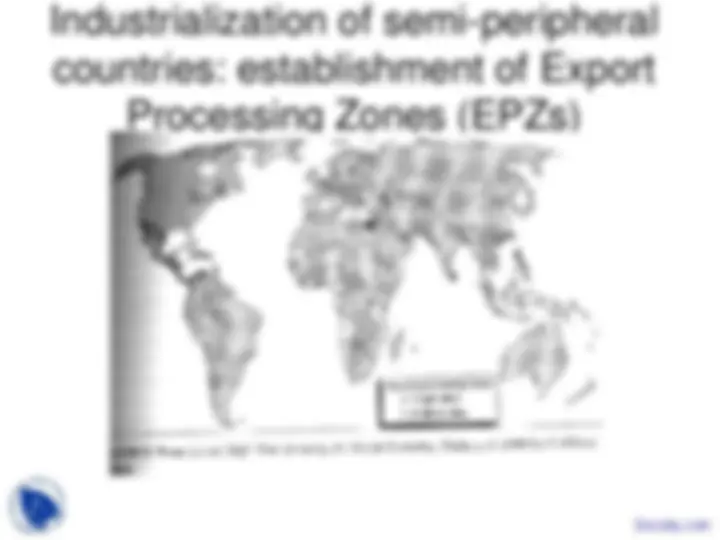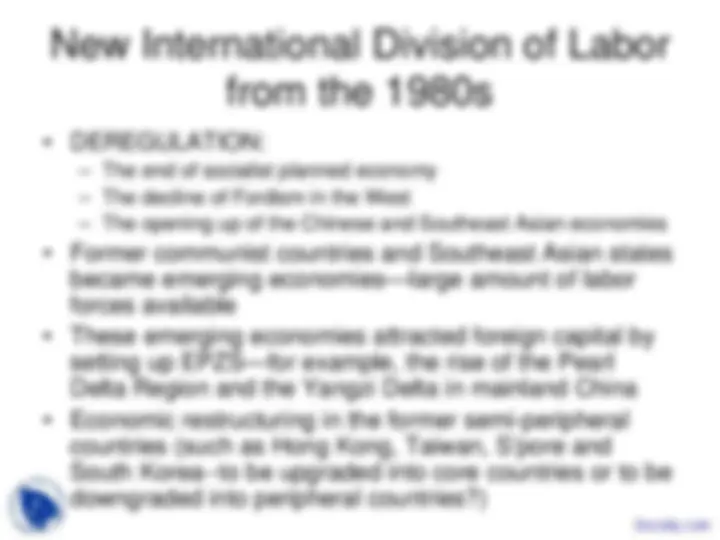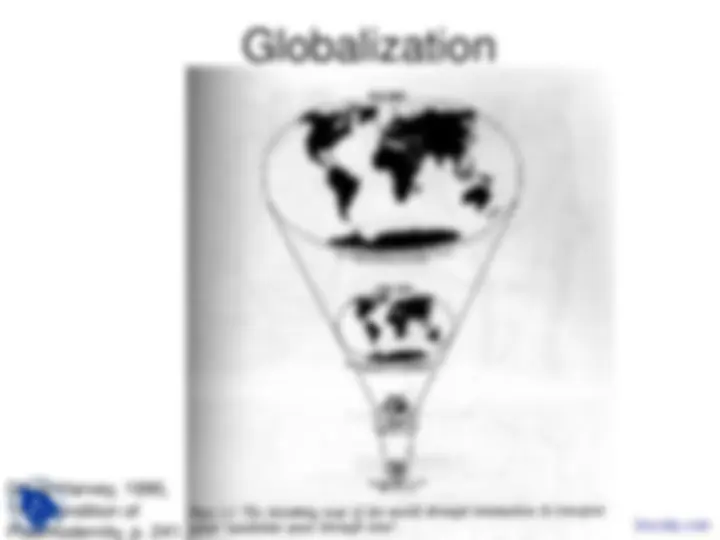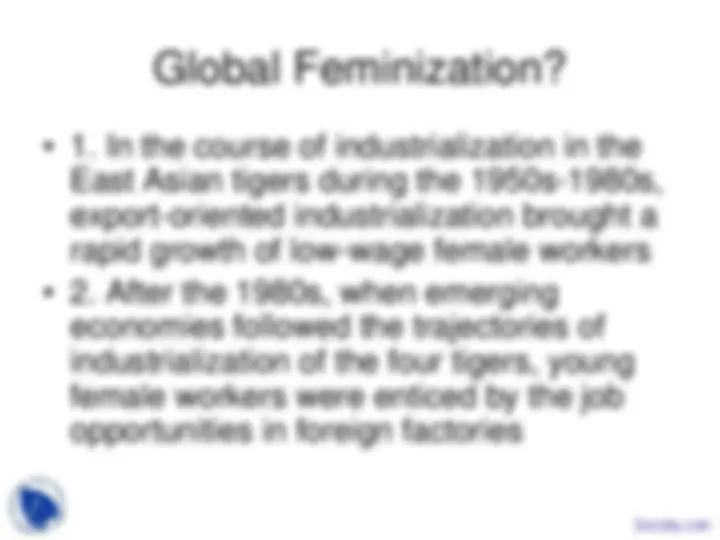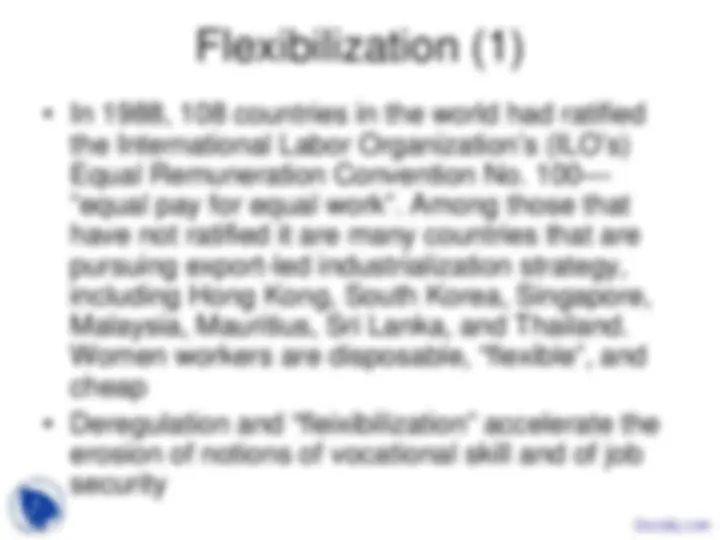Download Globalization & International Division of Labor: Historical & Contemporary Implications and more Slides Economic Sociology in PDF only on Docsity!
Lecture Note 11
Globalization and International
Division of Labor
Main Issues
• 1. International Division of Labor:
- what it is
- how it works this way (explanations)
• 2. Current Wave of Globalization
- the New International Division of Labor from
the 1980s
Classification of world nations
- The First World (the U. S.,
countries in Western Europe, and Japan)
Soviet Union, China and other socialist states)
rest—states in Latin America, Asian-Pacific region, and Africa)
- Or, in conventional terms:
developed countries, developing countries and under developed countries
- Theoretical terms (world- system paradigm)
- Core (the U. S., countries in Western Europe, and Japan)
- Semi-periphery (states in Latin America and Asian four tigers [Taiwan, Hong Kong, Singapore and South Korea]
- Periphery (the rest)
Wallerstein’s explanation on
development and underdevelopment
(1)
- Why are some countries well developed, while others are underdeveloped?
- According to Immanuel Wallerstein’s world-system paradigm, contrast between developed and underdeveloped countries is related to the colonial experiences
- Developed countries were colonizing powers in the sixteenth- and early twentieth-century world-economy
- Those “backward” countries were victims of colonialism
- Though colonialism was challenged in the waves of post- colonial revolutions throughout the world after the W. W. II., the ties between colonizing powers and colonized countries continued
Colonialism (1)
- From the fifteenth century, countries in Western Europe started to expand their territories throughout the world— establishment of various colonial settlements in the Americas, Africa, Southeast Asia
- At the turn of the twentieth century, Japan became the first and the only non-Western colonizing power
Christopher Columbus (1451-1506), the adventurer who “discovered” the Americas in 1492
Source: Philip McMichael, p. 5.
Colonialism (2)
Colonialism (4)
- What could a colonizing power benefit from colonization?
- “Unequal exchange” thorough colonial division of labor (the form of international division of labor between the fifteenth and early twentieth centuries)
- The colonial powers and their merchant companies exported manufactured goods such as cloth, guns, and implements for these products. Most of these manufactured goods were made of materials supplied by colonized countries (such as raw cotton from India, leather from North America, indigo, and other precious materials from South America)
- The colonized areas such as Africa supplied labor (slavery) to the colonizers in the Americas for the establishment of tropical plantations (cotton, sugarcane, coca, and coffee plantations)
Source: Philip McMichael, p. 8.
Colonialism (5)
Colonialism (6)
• After the nineteenth century, thanks to the
introduction of tropical plantations in
Ceylon, the Caribbean, British Malaya,
North African, etc., rapid growth of the
productivity of coffee, tea and sugar
became mass-consumption products.
These beverages became stimulus for the
nascent working population to adjust into
the factory work--see Sydney Mintz, 1985,
Sweetness and Power (Penguin Books)
The “luxury goods”: Asian products
in European markets
Chinese Ewer, ca. 1520 in Portuguese market
Now housed in the Metropolitan Museum of Art, NYC
Chinese Ewer, ca. 1715– (European market) Now housed in the Metropolitan Museum of Art, NYC Chinese, late 18th-century, made for export to Europe
Frank’s explanation on development
and underdevelopment (2)
- Why did countries involved in the intra-Asian trade fall after the nineteenth century?
- These countries (such as China, Southeast Asian states, and India) continued supplying European countries with raw materials for industrial development, so European countries developed. In the same time, the previous richer East Asian countries did not catch up the opportunities to engage in economic transformation. The critical moment occurred in the nineteenth century
- Assessment of Frank’s thesis on ReOrient : rightly emphasize the centrality of the intra-Asian trade (vis-à- vis the one-dimensional perspective on the European expansion). But Frank’s explanation for the decline of the East is not complete (see review of Frank’s work in Kenneth Pomeranz, 2000, the Great Divergence)
Transition of the colonial division of
labor to present-day international
division of labor
- The World War II and the rise of various post-colonial
movements
- Development of redistributive welfare states in both the
Communist Blocs and the Western countries [i. e., the socialist planned economy and practice of Fordism in mass-production manufactures in Western countries]
- Semi-periphery countries started to industrialize (by
catching up the opportunities of offshore production of Western enterprises)—rapid economic growth in Latin America and the East Asian tigers (Taiwan, Singapore, Hong Kong, and South Korea)
New International Division of Labor
from the 1980s
- DEREGULATION:
- The end of socialist planned economy
- The decline of Fordism in the West
- The opening up of the Chinese and Southeast Asian economies
- Former communist countries and Southeast Asian states
became emerging economies—large amount of labor forces available
- These emerging economies attracted foreign capital by
setting up EPZS—for example, the rise of the Pearl Delta Region and the Yangzi Delta in mainland China
- Economic restructuring in the former semi-peripheral
countries (such as Hong Kong, Taiwan, S’pore and South Korea--to be upgraded into core countries or to be downgraded into peripheral countries?)
Globalization
David Harvey, 1990, The Condition of Postmodernity, p. 241. Docsity.com

